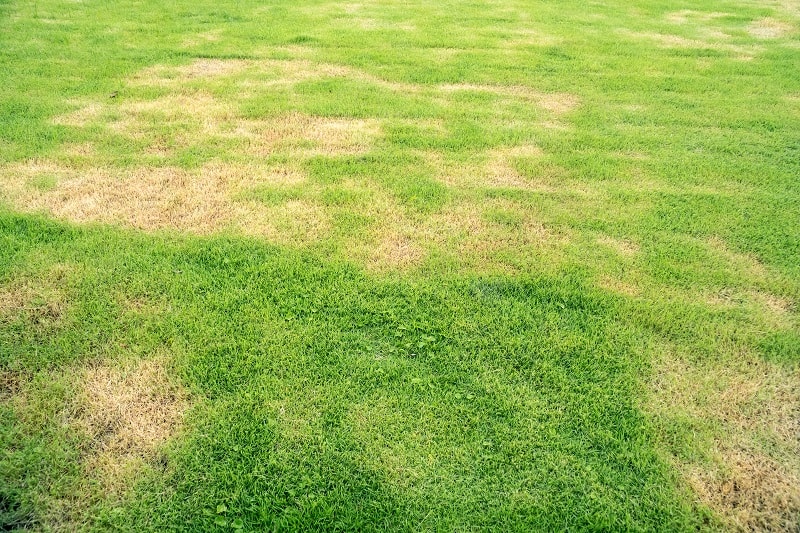
Homeowners tend to be very particular about their front lawns. Popular options when it comes to lawn grass include a combination of bluegrass, fescue and ryegrass. While most lawn grass is well maintained, certain issues, like yellowing grass, are not uncommon. Read on for some helpful information about why lawn grass turns yellow and how to prevent it.
Grass Turning Yellow: What Are the Reasons?
Here are some common reasons for lawn grass turning yellow:
1. It could be due to drought stress.
Grass needs water to survive and if it is inadequate the grass will begin to wilt and turn pale green or yellow. Consistent drought or hot weather can take a toll on your lawn grass. Ideally, there should be a regular watering schedule or an irrigation system to ensure that the grass is absorbing enough water.
Lawn grass needs at least one to one-and-a-half inches of water weekly, the whole year round, including in the winter season. You should water deeply at least two to three times per week instead of daily. Water the grass more frequently during hot weather.
2. It could be due to insect damage.
Insects could invade your lawn since they eat grass and roots. Insect-infested grass appears wilted, turns yellow, and ultimately goes brown. In parts of the US, common insects that invade lawn grass are grubs, armyworms and chinch bugs. There are insect control products available commercially to eradicate these insects, or you can seek the help of grass professionals.
3. It may be due to lawn disease.
Lawn grass discoloration could also be attributed to turf diseases such as fungal diseases. These can spread rapidly and make the grass turn yellow and eventually brown in color. Lawn fungus is aggressive, but there are fungicides that effectively control the spread of these diseases. You should also regularly monitor your grass.
4. It might be due to unwanted grass species.
Certain undesirable grasses tend to grow and blend in with your lawn grass. These unwanted grass species could infest your lawn which is why it turns pale green or yellow. Lawn aeration is helpful, as it removes thatches and weeds while encouraging good grass to grow healthily. Ideally, sodding and lawn renovation should also be carried out.
5. It could be due to nutrient deficiency.
Grass turning yellow could also be due to nutrient and nitrogen deficiency. The right application of fertilizer at the proper time of the year is essential for healthy lawn grass. You may opt to hire a lawn professional to ensure the best results.
6. It may be due to fertilizer burn or overfertilization.
Fertilizer application should be done with caution since applying too much on your lawn grass could lead to fertilizer burn. This can cause yellowing grass and create unsightly spots on your lawn. If you are not too sure of the proper procedures, it is best to consult a lawn professional.
Common signs of overfertilization include the following:
- Leaf blades are yellowing at the base.
- Leaf blades are turning brown at the top.
- There is a crust of fertilizer on the soil surface.
- The grass is slow-growing or has stunted growth.
7. It could also be due to dog urine.
Dog urine has a high concentration of nitrogen compounds. If your dog regularly pees on your lawn you will notice yellow spots on the grass.
Restoration Tips for Yellowing Grass
Here are some restoration tips if your grass is turning yellow:
- Allow plenty of sunlight on your lawn or yard by cutting back overgrown tree branches that could be barring full sunlight from the area.
- Mow only when the grass is dry and maintain sharp mower blades.
- Check and improve your lawn’s drainage.
- Rake and clean any excess grass clippings and fallen leaves from your lawn or yard.
- Fertilize as recommended by lawn professionals and check for any unwanted weeds.
- Water your lawn only when the two inches of topsoil has dried out.
- Reseed urine spots in your lawn.
- Treat lawn diseases.
- Hire a professional lawn care service for prompt maintenance of your lawn grass.
Conclusion
Lawn grass adds aesthetic appeal to any front or back yard. However, it can be prone to yellowing and discoloration for various reasons. Yellowing grass could be due to drought stress, insect damage, lawn disease, fertilizer burn or nutrient deficiency.
Image: istockphoto.com / Singjai20